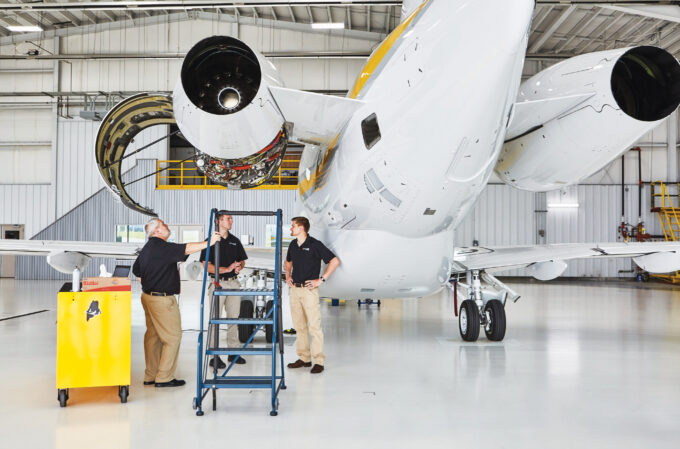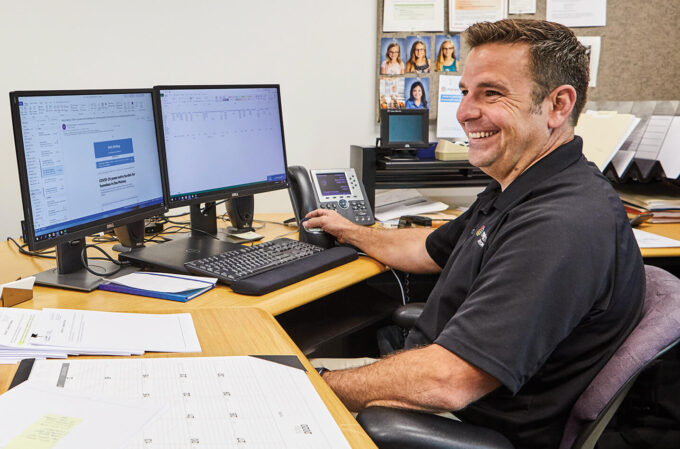As Ryan Campbell noted, “We’ve had some very long tenures in our department; some pilots and technicians have been here for over 40 years.” Campbell is director of aviation and chief pilot for media group Meredith Corp., where “people stay because of the company culture and consistent support from senior management.”
In fact, Meredith’s flight operation has sustained broad support across the company for decades. Since the early 1980s, it has repeatedly averaged 1,200 hours annually, flying two jets, carrying employees and clients between Meredith’s Des Moines, IA, headquarters, media markets in New York and magazine publishing or television broadcasting offices in 20 states.
Although Meredith’s aviation history dates back to the 1930s, when founder Edwin T. Meredith’s son flew a Waco UEC biplane, the flight operation has remained essential by adapting and being cost-effective.
“As a publicly traded company, we make sure we’re using business aviation
cost-effectively.”
Doug Olson President of Magazines, Meredith Corp.
Cost-Conscious
“As a publicly traded company, we make sure we’re using it cost-effectively,” said Doug Olson, president of magazines. “That’s why we have such high utilization. We try to keep it comparable to flying commercial.”
On the corporate shuttle that flies every Monday, Wednesday and Friday from Des Moines to New York, the Legacy 450s are often near max capacity. The shuttles make up about 45% of Meredith’s flight activity. The rest are trips to media offices or clients around the country. Filling the airplanes makes them cost-competitive with airline travel from Des Moines, where direct flights are limited. Returning the same day saves thousands of hotel nights per year. That would be impossible on the airlines.
When three or fewer people are traveling, however, even executives will take the airlines, if their schedule permits. The Legacy 450s are open to everyone in the company, but trip requests must be cost-effective to be approved.
“We have hardly any deadheads,” said Campbell. “Tankering fuel is also huge for efficiency. Of course, before anything else, safety is the top priority.”

Three technicians, led by Director of Maintenance Galen Tolliver (left), care for Meredith's airplanes.
Mastering the Handoff
Campbell arrived at Meredith Corp. in 2007. He became director of aviation in 2019, taking over for Gary Mishler, who remained in the department as a senior captain.
While Mishler had served as director since 1997, he wanted to hand over his leadership duties long before retiring. The former director and the new director working side-by-side made for a seamless transition.
“The whole succession plan was for Ryan to take over more and more responsibility before I transitioned out,” said Mishler. That plan prevented any loss of institutional knowledge, with Mishler on hand to answer questions.
Institutional memory was important during Campbell’s first year as director, when he started the transition from a paper-based safety management system (SMS) to a software solution. He also asked the team to begin digitizing the flight operations manual.
Newest hire Captain Josh Gipple was tasked with managing implementation of the new SMS alongside Senior Captain and Safety Officer Dave Perryman. With Perryman near retirement, pairing him with Gipple was guided by the department’s careful succession planning.
Perryman said, “Josh is a young guy, he’s sharp. I can’t wait to hand off the safety officer job, and the department will be better for it.”
“In transitioning to the new SMS system, we’re updating our manuals, procedures and everything.”
Josh Gipple Captain, Meredith Corp.
The Next Generation
The digital SMS and manual will make it simpler for pilots, maintenance technicians and Scheduler Diane Rivers to submit and review hazard reports and flight risk assessments while preparing the department for an external safety audit.
“In transitioning to the new SMS system, we’re updating our manuals, procedures and everything,” said Gipple, who was thrown into the role of safety-officer-in-training his first month on the job. Looking around at the long tenures of his colleagues, Gipple said he has found his dream job. “I plan on retiring here.”
Director of Maintenance (DOM) Galen Tolliver, who, after 25 years with Meredith, is also considering his successor, hired two new maintenance technicians in 2018, each about five years out of school.
“When you go to hire, there are candidates my age ready for the DOM job, and there are lots of young mechanics, but there’s a big chunk missing in the middle of the workforce,” explained Tolliver. “As a company, we had flown Learjets for 40 years, but the Legacy 450 was a new airplane [for us], so no one had experience on it. I decided to hire two younger technicians with a good work ethic and ability to learn.”
Publishing for Over 100 Years
Business aviation enabled Meredith to grow into a national media company, while staying rooted in the Midwestern values it was founded on.
E.T. Meredith started the company in 1902, launching Successful Farming magazine and later, Better Homes & Gardens. He served as Woodrow Wilson’s Secretary of Agriculture before returning to Iowa to lead the company through the Great Depression. His grandson Ted Meredith continued the family passion for aviation, earning a Learjet type rating.
As CEO, Ted Meredith also started the tradition of all-employee meetings. “The goal was to visit every employee in the company in a four-month span,” said Rivers, noting the tradition continued long after his passing. “Last year, we flew the senior leadership to 16 locations.”
Tying Meredith’s national media network together and providing access to New York has been a critical mission since the company’s professional flight department began in 1969. By the early 2000s, employee demand for travel to New York was so high, senior leadership asked for a twice-weekly shuttle. Soon, the shuttle was flying three days a week.
Any employee can log onto the company intranet and see the empty seats. By emailing Rivers, they can reserve a seat or ask to be wait-listed. In 2019, the aviation team flew 2,533 passengers.
“We’ve always had an open policy; anybody in the company can get on the aircraft,” said Rivers. “So we’ve always been very efficient.”

Ryan Campbell, director of aviation/chief pilot, joined the company in 2007 and ascended to his current leadership position in 2019.
Working Through COVID-19
When the pandemic was at its peak, Meredith paused most of its flight operations. However, the company still flew a limited number of missions per week, with some executives sheltering-in-place with family outside Iowa.
In early March, as the pandemic spread across the U.S., the aviation team completed a disinfection of the cabins and cockpits. Then a contractor applied a long-lasting anti-microbial shield to all the airplanes’ inside surfaces.
The Legacy 450s enabled company leaders to commute to Des Moines on Mondays and home on Fridays. Passengers, pilots and maintenance technicians all maintained social distance. One technician prepped the airplane at the hangar but stayed at least six feet from the pilots. While the passengers boarded, the pilots remained in the cockpit. During flight, before approach, the copilot called the FBO to pay for fuel and landing fees with a credit card.
“People are going to be reluctant to take the airlines for a while. We’re preparing for that: planning for how we prioritize our trips.”
Ryan Campbell Director of Aviation and Chief Pilot, Meredith Corp.
“We’re keeping our distance from each other,” explained Sean Davis, assistant chief pilot, who manages standardization, pilot training and crew scheduling. “The passengers are being good about it, too. We’re trying to mitigate the potential risk as much as we can.”
During the lull in flying, all aviation personnel took advantage of the downtime. Running single-person shifts for social distance, the technicians caught up on minor maintenance items. While working from home, all personnel pursued e-learning and virtual training.
However, the downtime created significant challenges. Meredith normally sends pairs of pilots to recurrent training every nine months. This year, because of the decline in flying hours, the recurrent training schedule will be trickier to manage, and it will be harder for pilots to train together.
It has also thrown off the regular schedule for maintenance downtime.
“Normally, we’re able to do our 12-month and 750-hour inspections at the same time,” said Tolliver. “This year, however, we won’t be able to do that because we’re not flying as much.”
Above all, the aviation and company leadership is focused on how to safely emerge from the partial shutdown.
“I predict we’re going to be busy,” said Campbell. “The airplanes are open to everybody at Meredith. People are going to be reluctant to take the airlines for a while. We’re preparing for that: how we prioritize our trips, deciding whether to fill the airplanes or cap the number of passengers. My plan is, when we start coming out of this, I want to be 100% ready to go.”
Snapshot
Aircraft: Two Embraer Legacy 450s
Base: Headquartered at Iowa’s Des Moines International Airport (DSM)
Personnel: Seven pilots (including the director), three maintenance technicians and a flight coordinator



 International Business Aviation Council Ltd.
International Business Aviation Council Ltd.